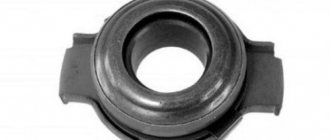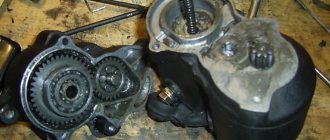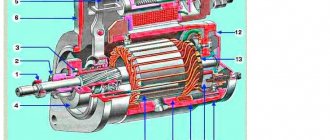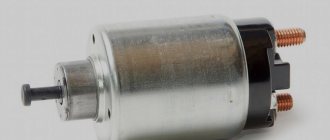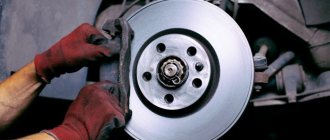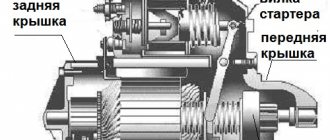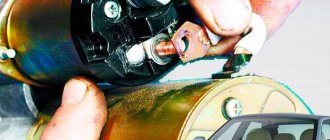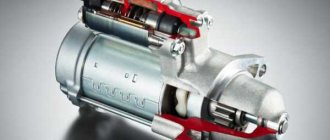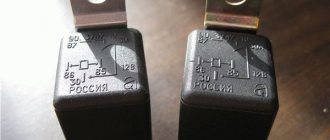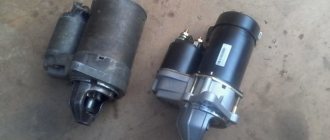The only way to start a car engine is to crank the crankshaft with the starter (handle, tow, “pushing” does not count, especially on cars with an automatic transmission). If this unit is faulty, the machine will be immobilized.
From our material you will learn the reasons why the starter turns the engine poorly or slowly, how to find and eliminate them, and how to crank the engine by hand.
Despite the fairly simple design (electric motor, movable rod with drive gear and electromagnet), there are quite a few different breakdowns of this element. Each of them has its own symptoms.
The press release was prepared by the website Twist-speedometer.ru - high-quality mileage adjustment without traces of intervention.
Why does the starter turn the engine poorly (slowly)?
The first and obvious reason is a dead battery. Even a working starter requires a lot of energy to spin the crankshaft, and a weak battery is not able to provide sufficient current.
It could also be a matter of poor contact, and as a result, high resistance in the starting circuit. Part of the current is spent overcoming resistance, and the starter does not turn the engine. It is necessary to check the resistance between the lead contact of the battery and the screw contact of the starter. The malfunction is easily fixed. You just need to clean the oxidized (dirty) contacts and treat them with a special lubricant to protect them from moisture.
If the contacts are OK but the resistance is still high, check the power wires. They become hot during operation and are susceptible to moisture. The copper threads of the harness can simply corrode, reducing the cross-section of the conductor and, accordingly, the resistance.
The starter may rotate the internal combustion engine slowly due to the fact that the engine oil is too thick. The symptoms are as follows: on a hot engine, starting without problems, on a cool engine - with great difficulty.
The starter does not turn on a hot engine
Again, poor contact may be to blame. When heated, the metal deforms slightly and the contact area decreases.
If the relay clicks and the starter motor does not turn, look for the cause in the brush assembly. Worn brushes can “hang” in the guides when heated. If you lightly tap on the body, performance is restored.
Rotor bushing play. It may move from its working position and jam when heated.
The starter works, but does not turn the engine
With this malfunction, it is not possible to diagnose the entire assembly at the same time, so we simply hear the noise of a rotating electric motor and conclude that it is working.
If the electric motor is running but the crankshaft does not rotate, it means there is no clutch with the flywheel gear. There are several reasons:
- Mechanical wear of the Bendix gear. Checked visually. Cannot be repaired, only replaced.
- The starter relay is burnt out. The contacts can be closed manually; if the retractor works, the reason has been found.
- The retractor solenoid is burnt out. This is checked by directly applying power to the contacts.
- The retractor solenoid works, but the bendix gear does not move. A possible reason is a mechanical failure of the Bendix fork.
- The least likely cause is a broken starter shaft. But this problem also occurs.
The starter cannot crank the engine - we are looking for reasons sequentially
The fault is identified from simple to complex. We start with the supply voltage, contacts, wiring quality. Then we check individual nodes by connecting power directly. If the problem is not found, we diagnose the mechanical parts.
Then there remains a problem unrelated to the starter - the engine itself. Perhaps the starter simply cannot crank the crankshaft.
How to crank the engine manually?
Important! You can start the engine in this way only on older carburetor models.
The crankshaft is turned only to exclude the internal combustion engine from the chain of starter problems. With the spark plugs turned off, you can turn the ridge belt drive pulley with your hand. You can also evaluate the freedom of rotation using a torque wrench placed on the crankshaft pulley nut.
On cars with a manual transmission, you can engage 3rd or 4th gear and tow the car (or push start it).
If the resistance on the shaft is too high, the cause may not be the starter.
1200 rub. for the photo report
We pay for photo reports on car repairs. Earnings from 10,000 rubles/month.
Write:
The reasons that the starter does not turn may be a malfunction of the retractor relay, a weak battery charge, bad electrical contacts in the circuit, mechanical failure of the starter, and so on. It will be useful for every car owner to know what to do if the starter does not turn the engine . Indeed, in most cases, repairs can be done yourself. Moreover, a breakdown usually occurs at the most unforeseen moment, when it is not possible to use the help of a car repairman. Next, we will consider in detail the causes of the malfunction and methods for eliminating them.
Signs of a faulty starter
There are actually many reasons why a car won't start. However, a faulty starter can be determined by the appearance of one or more of the following symptoms:
- the starter does not turn on;
- the starter clicks, but does not turn the engine crankshaft;
- when the starter is turned on, the crankshaft rotates very slowly, which is why the engine does not start;
- You can hear the metallic grinding sound of the Bendix gear, which does not mesh with the crankshaft.
Next, let's move on to discussing the possible causes of a possible breakdown. In particular, we will analyze situations when the starter either does not rotate at all or does not rotate the engine crankshaft.
Brush unit
If interruptions in the starter operation are observed even at idle, then there is a high risk of problems in the brush assembly. The presence of unstable electrical contact leads to slow rotation of the armature, as a result of which the motor does not catch and does not enter the independent operation mode.
Unreliable contact often occurs due to brushes getting stuck in the guides. Therefore, first of all, it is important to check their free movement.
A large current flows through the brushes. It causes thermal damage such as melting. Therefore, it is important to inspect all elements for defects.
Particular attention should be paid to surfaces in contact with the collector. They are most often damaged. Minor defects require sanding. If it is impossible to eliminate the damage, the brush must be replaced.
Brushes are the most susceptible to wear. You can determine the remaining life by measuring their length. Further decisions should be made by referring to the table below.
Table - Brush wear
| Wear level | Action |
| Complete erasing down to the wires | Mandatory replacement. Even test starts of the starter are prohibited during repairs. There is a risk of damaging the anchor. |
| Less than 30% of original size left | Mandatory replacement before assembly |
| There is half a brush | The need for replacement should be determined by the condition of the remaining elements |
| More than 70% of original size left | It is recommended to reuse the brush |
Reasons why the starter does not turn
Often the reason that the car does not start and the starter does not turn the flywheel is a discharged battery . This reason is not directly related to the breakdown of the starter, however, before diagnosing this unit, it is necessary to check the charge of the battery and, if necessary, recharge it. Most modern car alarms block the starter circuit if the voltage level from the battery is 10 V or lower. Therefore, you will not be able to start the engine under this condition. To prevent this from happening, monitor the battery charge level and recharge it periodically if necessary. Also be aware of the density of the electrolyte. However, we will assume that everything is in order with the battery charge level.
The starter clicks but doesn't turn over
Inspection of starter brushes on VAZ-2110
Very often, when the starter malfunctions, it is not the mechanism itself that is to blame, but its retractor relay. It is important to understand that when you turn on the ignition, it is not the starter that clicks, but the mentioned relay. Malfunctions consist of one of the following reasons:
- Failure of the power wire that connects the starter windings and the traction relay. To solve the problem it is necessary to replace it.
- Significant wear on starter bushings and/or brushes. In this case, they need to be replaced.
- Short circuit on the armature winding. You can check this using a multimeter. As a rule, the winding is not repaired, but another starter is purchased and installed.
- Short circuit or break in one of the starter windings. The situation is similar to the previous one. The device needs to be replaced.
- The fork in the bendix is broken or deformed. This is a mechanical failure that is difficult to fix. The optimal solution in this situation would be to replace the bendix or the fork separately (if possible).
Replacing the Bendix starter: step-by-step instructions with photos
Like the brushes, you can also replace the Bendix with your own hands without much difficulty. This section provides step-by-step photo instructions for replacing the Bendix starter. As in the previous case, it is quite universal.
Step 1: Start by unscrewing the brush assembly nut from the relay bolt.
Unscrewing the brush assembly nut from the relay bolt
Step 2. Then you need to remove the contact of the brush assembly output from the relay bolt, which was discussed above.
Removing the brush assembly output contact
Step 3. Then you need to unscrew the tension screws that secure the traction relay to the mask. There are three of them and they are all located nearby.
Unscrewing the clamping screws
Step 4. Next you need to pull the relay out of its seat.
Removing the relay from its seat
Step 5. Only after this can you unscrew the coupling bolts of the starter itself as in the instructions above in step 3 and remove the motor from the housing.
Unscrewing the starter pinch bolts
Removing the motor from the housing
Step 6. The next step is to remove the relay core.
Removing the Relay Core
Step 7. Next you need to remove the gearbox from the housing. You are almost there.
Removing the gearbox from the housing
Step 8. You need to remove the fork from the gearbox that secures the bendix.
Removing the fork that fixes the bendix
Starter fork removed
Step 9. Then you need to knock the retaining ring off the gearbox shaft. To do this you will need a hammer and chisel.
Removing the retaining ring from the gearbox shaft
Retaining ring removed
Step 10. All that remains is to remove the old damaged bendix and replace it with a new one.
Removing a damaged bendix
Step 11. At this stage, you should install the new bendix in its rightful place.
Installing a new Bendix
Step 12. Now you need to assemble the starter by repeating steps 9 to 1 in reverse order. The locking ring is clamped using pliers.
Reassembling the starter
The starter does not turn when hot
Starting the engine directly
Sometimes car owners have problems when the starter does not turn “hot”. That is, with a cold engine, after a long period of parking, the car starts without problems, but when it heats up significantly, problems arise. In this case, the most common problem is incorrectly selected starter bushings, that is, having a smaller diameter than required. When heated, a natural process of increasing the size of the parts occurs, which is why the starter shaft jams and does not rotate. Therefore, choose bushings and bearings in accordance with the manual for your car.
Also, in extreme heat, contacts in the vehicle's electrical system may deteriorate. Moreover, this applies to all contacts - on the battery terminals, the solenoid and main starter relay, on ground, and so on. Therefore, we recommend that you inspect them, clean and degrease them.
Closing the starter directly with a screwdriver
Summarize
As you have already noticed, there are many options why the starter does not want to turn. And not all of these problems can be solved on your own. Since the starter is located extremely inconveniently (at the bottom of the engine), its repair causes a lot of trouble. Even just to remove the starter requires certain skills and suitable tools. Therefore, if you are not confident in your abilities, do not try to solve the problem yourself - seek professional help!
If you have any questions, leave them in the comments below the article. We or our visitors will be happy to answer them
Emergency engine starting methods
When the starter does not click or make any sounds at all, the engine can be started if it is closed “directly”. This is not the best solution, but in cases where you need to go urgently and there is no other option, you can use it.
Let's consider the situation of how to start the engine directly using the example of a VAZ-2110 car. So, the sequence of actions will be as follows:
- engage neutral gear and set the car to the handbrake;
- turn on the ignition by turning the key in the lock and open the hood, since we will carry out further actions in the engine compartment;
- remove the air filter from its seat and move it to the side in order to get to the starter contacts;
- disconnect the chip going to the contact group;
- use a metal object (for example, a screwdriver with a wide flat blade or a piece of wire) to short-circuit the starter terminals;
- as a result of this, provided that the other components listed above are in good working order and the battery is charged, the car will start.
After this, install the chip and air filter back. An interesting fact is that in most cases the engine will continue to be started using the ignition key. However, you should remember that the breakdown still remains, so you need to look for it yourself or go to a car service center for help in order to fix it.
Emergency engine start
We offer you another method that will be useful to you if you need to start the engine in an emergency. It is only suitable for front wheel drive passenger cars with manual transmission! The algorithm of actions is as follows:
- it is necessary to jack up the car by hanging any of the front wheels;
- turn the hung wheel outwards all the way (if the left wheel - then to the left, if the right wheel - then to the right);
- wrap a tow rope or strong rope around the surface of the tire 3-4 times, leaving 1-2 meters free;
- engage THIRD gear;
- turn the key in the ignition;
- pull strongly on the end of the cable, trying to spin the wheel (it is better to do this not in place, but with a slight run-up);
- when the car starts, first of all set the gear to neutral (you can do this without pressing the clutch pedal) and wait until the wheel stops completely ;
- lower the hanging wheel to the ground.
The described method of spinning the wheel of front-wheel drive cars is reminiscent of the method of starting a crooked starter (using the crank) used in old rear-wheel drive cars (for example, VAZ “classic”). If in the latter case the starter is spun using a handle, then in front-wheel drive cars it is spun from the axle shaft on which the raised wheel is located.
Conclusion
The starter is a simple but extremely important mechanism in a car. Therefore, its failure is critical , as it does not allow the engine to start. In most cases, problems are related to the car's electrical wiring, poor contacts, broken wires, and so on. Therefore, if the starter does not turn over and does not start the engine, the first thing we recommend is that you inspect the contacts (main ground, relay contacts, ignition switch, etc.).
Due to changes in the scope of the training program, when preparing for driving courses to obtain driving licenses of various categories, during training very little time is devoted to the design of the car, including the design and operating principles of the internal combustion engine.
Misunderstanding of the purpose of various engine components and the principles of their operation often leads to an incorrect description of the malfunctions that have arisen. One such description is “the starter does not turn the engine.”
With such a description of the malfunction, it is very difficult to understand what the real reason is. Especially if there is no understanding of the level of technical literacy of the car owner. In some cases, this description of the malfunction may mean that the electric motor drives the flywheel and crankshaft of the engine, but does not start.
When is the best time to contact the service?
If, when turning the key, a clear click is heard, but the starter does not rotate, then there may be a breakdown of the rotor or starter windings and, as a result, a short circuit. This is a fairly rare problem associated with damage to the integrity of the windings. In this case, they can short-circuit both to the body and to each other. Here you will need the help of an auto electrician to solve the problem.
Why doesn't the starter turn?
A malfunction such as magnets peeling off can also show the same symptoms - which, by the way, is also very rare. And here, too, you need the help of a specialist. In principle, it is possible to correct the situation on your own, but to put the magnet in place, you need special glue.
Peeling off the magnets on the starter
Problems of an electrical nature, when you also need the help of a specialist, also include “glitches” of the immobilizer and alarm system. We need both systems to prevent criminals from stealing a car. And when the systems are active, they prevent the starter from receiving power and prevent the car from starting. And if there is something wrong with the security systems, they do not turn off and do not allow the starter to receive current. Here you should not solve the problem on your own - entrust the health of the iron horse to specialists.
Starter
The starter is an electric DC motor. The main purpose of this structural element is to set in motion the connecting rod and piston group to ensure the initial compression of the fuel-air mixture (FA) in the cylinders. To ensure engine starting, spinning the flywheel to a frequency of 50-70 rpm is sufficient.
At this speed of rotation and the normal state of the cylinders, pistons and rings, compression of the fuel-air mixture is ensured to the degree necessary to ignite the fuel assembly and transfer the energy of the ignited mixture to the shoulders of the crankshaft. Then the process occurs independently.
Thus, the electrical device does not directly affect engine starting, but is only an auxiliary unit for the initial spin-up of the crankshaft.
The main purpose of using this electric motor is to eliminate the need for physical force and ensure ease of use of the car.
Starter design
Structurally, the starter consists of three blocks:
- DC motor
- solenoid relay
- bendix (gear that transmits torque to the flywheel of an engine with an overrunning clutch)
The power supply to the electric motor winding is supplied not directly from the battery, but through the ignition switch. At the same time, when the lock is closed, an electric current is supplied to the coil of the retractor relay, causing it to operate and close the contacts located inside the retractor coil housing, supplying current from the car battery to the commutator brushes of the electric motor through the contact pins hidden under the casing.
Unreliable connection between the traction relay and the electric motor
If, after turning the ignition key, the solenoid relay clicks, but the electric motor does not hum, then the culprit is often the conductor connecting them to each other. Under the influence of an aggressive environment and passing large currents, the wire gradually deteriorates. To eliminate the break, it is recommended to weld or solder a new copper conductor.
Starter malfunctions
Starter malfunctions are divided into two categories
- mechanical failure or wear
- damage to the electrical circuit
Since the motor shaft spin-up device consists of two electrical elements, damage to the electrical circuit is also divided into two subcategories:
- electric motor malfunction
- Solenoid relay malfunction
Malfunction of the mechanical part of the starter can be repaired by replacing the bearings or bendix.
Bushing wear and damage
The appearance of wear or damage to the bushing is indicated by a characteristic grinding noise when starting the engine. If you do not pay attention to this symptom for a long time, the starter will start turning too slowly. A gasoline engine is less critical of reducing speed, while a diesel engine may refuse to start at all.
To diagnose, rotate the armature shaft. If it turns tightly, there is a high risk of damage or wear to the bushings. For a more accurate check, you should disassemble the assembly and visually inspect the contacting surfaces.
Starter malfunction and cause
The starter hums, but does not turn the engine.
Indicates that the electrical circuit is being closed and power is being supplied to the motor brushes. The electric motor is in working condition. The holding coil of the solenoid relay does not operate and the bendix does not move. Bendix gear does not engage with flywheel gear. The electric motor runs in idle mode. The cause may be either mechanical or electrical in nature.
Mechanical part. The force from the relay retracting element is transmitted to the bendix through a plastic lever shaped like a grip. If there is high resistance to the movement of the bendix along the rotor shaft, this plastic part breaks. The Bendix does not move to the working position, and the starter rotates without transmitting torque to the flywheel.
An indirect cause of failure of the plastic grip may be wear of the teeth on the rotor shaft of the electric motor or wear of the teeth on the mating part of the bendix. For repairs, you will need to disassemble the starting unit and replace either the lever itself or the lever and bendix.
Another mechanical reason for the starter idling is the destruction of the teeth on the engine flywheel. The malfunction refers to a motor failure and is not directly related to the operation of the drive. The likelihood of such a malfunction may be indicated by the activation of all working elements of the starter, the spin-up of the electric motor and the transfer of the bendix to the working position, which is detected by a characteristic click when turning the ignition key.
To confirm the likelihood of such a breakdown, you should move the car with 3rd or 4th gear engaged without turning on the ignition by 0.5 m. This will lead to a shift in the position of the faulty part of the flywheel. Repeat the start in normal mode by turning the ignition key. If the engine starts, then it is necessary to check the condition of the flywheel at a service station.
In technically complex starters with planetary gearboxes, the gearbox teeth may break. This requires replacing the entire unit. The planetary gearbox is not available as a spare part.
Electrical part. If the starter hums but does not turn the engine, the fault may be localized in the solenoid relay. The solenoid relay, mounted on the starter housing and having terminals for electrical connection, has two windings:
The purpose of the windings is different and therefore they create different forces. The retractor winding is designed to close the contact pins and transfer voltage from the battery to the brushes of the electric motor. Retaining - designed to create a force sufficient to reliably engage the Bendix gear and the toothed rim of the engine flywheel. Idle operation indicates normal operation of the retractor winding and contact closure.
When there is an interturn short circuit in the holding winding, the bendix is not fixed in the working position and it is ejected from engagement. Torque is not transmitted to the connecting rod and piston group and the engine does not spin up. Repair is carried out by replacing the solenoid relay. If a separately supplied relay is not available, the starter is replaced entirely.
The starter does not rotate when the ignition key is turned
The problem is mainly related to the electrical circuit. The cause of the malfunction may be the following elements:
- ignition switch contact group
- protective relay
- solenoid relay
- electric motor brush assembly
Initially, you should check the operation of the starter relay located in the relay block, replacing it with a known good one. The starter relay is a standard 4-pin. If you have sufficient electrical installation skills, you can use relays from any manufacturer, ensuring the correct connection.
Another cause of the malfunction is the lack of contact in the wire going from the starter relay to the solenoid relay. If the terminal is not sufficiently secured, the wire falls out of the mounting socket and voltage is not supplied to the pull-in and holding windings of the pull-in relay. can be eliminated by crimping the terminal and restoring the electrical connection.
Malfunctions of the solenoid relay and brush assembly are eliminated by overhauling the starter and replacing the faulty parts.
On the mechanical side, the starter rotor plain bearings may wear out and “stick” to the magnets.
How to understand that the problem is in the starter?
But if suddenly your car stops starting, how can you understand that the problem is in the starter? After all, there can be a huge number of reasons for the malfunction of the iron horse. In fact, it is simple to understand that the reason lies precisely in the starter. When you try to start the car when you turn the key, the engine shows no signs of life, and from under the hood you hear a buzzing, clicking, ringing, grinding or absolute silence. This symptomatology is typical for cases associated with malfunctions of both the starter itself and its control system.
Car starter diagnostics
Let's try to do a little diagnostics. First of all, we check whether the battery is charged. If the current supplied to the starter from the battery is not enough, then the mechanism simply will not turn, but in fact, everything is fine with the starter itself. Just need to charge the battery a little. And, of course, we check the voltage on the battery using a voltmeter: if its value is lower than 9V, then the battery requires recharging.
Checking the starter
It is also worth checking whether the battery terminals are in place and whether all main contacts are in order. Violation of the contact level in one place or another leads to the fact that the current for the starter is again insufficient, and it cannot perform its functions.
